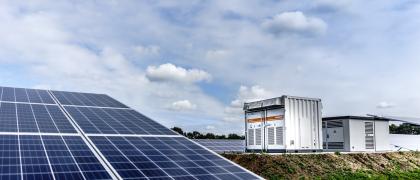
Second-life batteries: from e-vehicle to energy storage
With the increasing number of vehicles with electric drives, the question of what happens to the drive batteries at the end of their first life cycle is becoming steadily more important. Although these batteries may no longer be suitable for operating e-vehicles, they often retain a significant part of their charging capacity.
In this article, we take a closer look at how the drive batteries of e-cars are given a second life with the help of innovative technologies and what economic and ecological advantages this offers.
Reactivating used e-vehicle batteries
When traction batteries reach the end of their first life cycle, they can be used for various subsequent applications. These range from energy storage to grid stabilisation. This not only significantly extends the useful life of the batteries, but also contributes to sustainability by reducing electronic waste.
Discarded batteries from e-vehicles, for example, can be given a second purpose in stationary storage systems. In these systems, surplus renewable energy can be temporarily stored for later use. In this way, the energy from solar, hydro & wind plants is also available to the power grid outside of their respective core generation times. By reviving old e-vehicle batteries, the need to produce new batteries is reduced and the environmental impact is lowered.
How does the principle of second-life batteries work?
The technical feasibility of second-life batteries depends on various factors, including the original battery chemistry, the usage patterns during the first life cycle and the quality of the repackaging of the batteries. The process here is as follows:
- Evaluation of the batteries: The process usually starts with the assessment of used e-vehicle traction batteries, which involves determining their remaining capacity and general condition. This assessment can be used to determine which batteries are suitable for a second life.
- Sorting of batteries: Batteries that meet certain criteria, such as retaining a minimum level of capacity and passing safety tests, are selected for reuse.
- Repackaging of batteries: In order for the selected batteries to be used in energy storage systems (ESS) or other applications, they must be repackaged or repackaged. ESSs can range from small units for residential use to large systems for commercial, industrial and/or grid applications.
- Integration with new battery management system (BMS): To ensure the safe and efficient operation of batteries, the health and thermal characteristics of individual battery modules must be monitored and charges controlled with a battery management system. The BMS is a crucial component in second-life batteries.
Use cases of second-life batteries from e-vehicles
Once used e-vehicle batteries have been evaluated, sorted, repackaged and integrated into a new BMS, they are available for various applications. From stationary energy storage for the family home to industrial grid stabilisation systems - depending on the application, several batteries can be connected in series or parallel to achieve required voltages and capacities:
- Use in energy storage systems: Here, second-life batteries store surplus energy generated from renewable sources such as wind, hydro or solar power. The batteries store the energy during off-peak periods, when electricity is cheaper, and can release it during peak load periods or periods of lower renewable generation.
- Use in grid support systems: Second-life batteries can contribute to the resilience and reliability of the electricity grid by stabilising the grid voltage and frequency. They help manage peak loads and can provide backup power to the grid in the event of power outages.
When second-life batteries reach the end of their second life, traction batteries are recycled. This ensures that as many of the limited resources processed in them as possible, for example lithium, cobalt, nickel and copper, are recovered. These resources can be reused for the production of new batteries or other industrial applications.
Second-life batteries as a challenge & opportunity
Second-life batteries represent a synergy of technological innovation and economic and ecological sustainability: Used e-vehicle traction batteries are given a new lease of life, electronic waste is reduced and their use in complex energy storage systems contributes to a more stable power grid. However, the integration of used e-vehicle batteries into different energy systems demands a lot from companies: In addition to the use of robust technologies, the complex steps require skilled workers with specific knowledge of electrical engineering.
Despite these challenges, the opportunities and advantages of second-life batteries outweigh them: The useful life of e-vehicle batteries is significantly extended and electronic waste is substantially reduced. When used correctly, the reusability of traction batteries makes an important contribution to a more sustainable energy ecosystem.
Further information